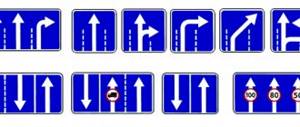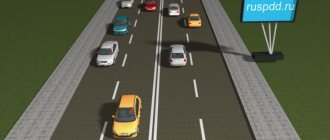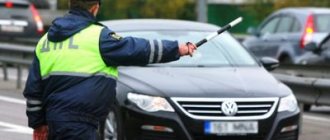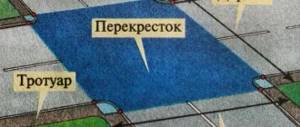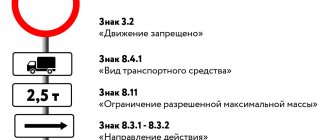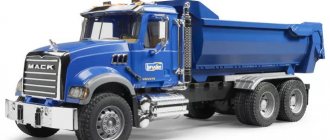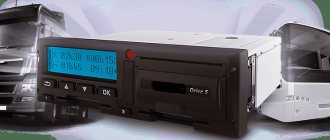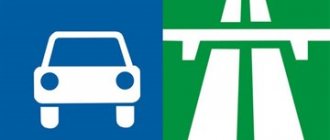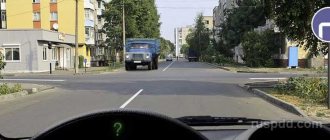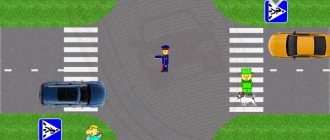What changes are being made to the traffic rules?
Despite the fact that the Law “On Road Traffic Safety” stipulates requirements for drivers to comply with the work and rest schedule, and the corresponding vehicles are equipped with devices that monitor this type of violation - so-called tachographs, there were no clear instructions prescribing the work and rest schedule .
Let us remind you that from November 1, 2021, individuals will be required to install tachographs on their trucks (now this applies to legal entities and individual entrepreneurs). And in a year, from the beginning of July 2021, tachographs will also be installed on city buses.
At least, it will be specific enough for drivers to understand when they have stopped turning the steering wheel, and for regulatory authorities to have clearer and more developed tools and grounds for inspections. Let us remind you that tachographs, in particular, have the right to be checked by traffic police officers.
Driving with a trailer in a pickup truck or van
There is a road sign 3.7 prohibiting the movement of trucks with trailers:
Traffic rules of the Russian Federation, road sign 3.7 “Moving with a trailer is prohibited.” It is prohibited to drive trucks and tractors with trailers of any type, as well as tow motor vehicles.
It is clear that according to the traffic rules, this sign prohibits the movement of all trucks with trailers, incl. both pickups and small vans. At the same time, passenger minibuses and jeeps similar in appearance can pass here.
Don't forget that any vehicle can be converted. Sometimes you can quickly and inexpensively convert, say, a cargo van based on a minibus into a passenger car by installing an additional row of seats, glazing and removing the partition between the front row of seats and the cargo compartment. Just don’t forget to register the conversion with the traffic police, otherwise, when you meet with a traffic police officer, your car may be towed.
Why are these changes being made to the traffic rules?
Of course, they could be enshrined in one of the numerous orders or instructions, but the change is so important for road safety that the legislator decided to register it not just anywhere, but in the most important document for all drivers - the Traffic Rules. There will be no discrepancies regarding violation of established rules in this option, and they will have to be followed clearly: from start to finish.
And to make it easier for professional drivers to navigate when studying at a driving school and searching for norms in the Rules, the topic is highlighted in the traffic rules as a separate paragraph under number 26. Which once again emphasizes the importance of the introduced norm.
Location on the roadway
The key to road safety is compliance with the rules and regulations prescribed in the traffic rules. They determine special requirements for freight transport when choosing lanes for traffic on roads of various categories.
The point “Location of vehicles on the roadway” is point 9 in the traffic rules, you can familiarize yourself with it.
In populated areas
According to clause 9.4, there are restrictions on the movement of all trucks weighing more than 2500 kilograms. Drivers of such vehicles can occupy the leftmost lane (if there are three or more lanes) only in two cases:
- when turning;
- when turning left.
It is worth paying close attention to the fact that this category includes a number of cars that many define as passenger cars (conditionally belonging to category “B”) - these are pickups and GAZelles.
The city has no other requirements for trucks. They are equal to all vehicles. Traffic restrictions can only be introduced using signs. For example, driving heavy trucks through the center is often impossible.
Outside populated areas
The previous rule is also common when driving through populated areas where the main road is located. The following rule applies here: “stay as far to the right as possible.” If the right lane is busy, you can move along the one located to the left, but as soon as the right side is free, you will need to occupy it.
Outside populated areas, the left lanes are used for heavy traffic and overtaking. Drivers of cargo vehicles with a permissible weight over 2500 kilograms should not forget about paragraph 9.4 described above.
On motorways and roads for cars
Motorways and roads for cars are indicated by the following signs (5.1, 5.3). Movement along them is carried out using certain rules. They are general and apply to both road options (see clause 16.3).
Let us define general traffic rules for all vehicles of this category:
- freight transport weighing from 2500 to 3500 kilograms can move in any lanes (if there are three or more), but they have the right to occupy the far left only for a U-turn or a left turn;
- all trucks with a permitted weight of 3,500 kilograms or more have the right to drive on such roads only in the two outer right lanes (in accordance with the rule of clause 16.1, entering any other lane is strictly prohibited);
- light trucks weighing no more than 2,500 kilograms can occupy any lane on such roads; there are no restrictions for them.
If traffic rules are violated, the driver faces prosecution, which we will discuss below.
According to the new rules, how long can a driver stay behind the wheel?
So, paragraph 26 of the Rules prescribes:
drive a vehicle without stopping to rest for no more than 4 hours 30 minutes from the moment you start driving the vehicle;
This must be followed by a 45-minute rest. At the same time, we note that the rest break must be at least this period of time. All this will be reflected in the tachograph record, so non-compliance, which constitutes a violation, can be easily identified and a fine issued.
The rest break is counted from the moment you begin driving a vehicle or from the moment the next period of driving a vehicle begins;
The legislator also provided that the 45-minute period can be divided into parts. That is, within 4.5 hours it will be possible to stop once for at least 15 minutes, and after the first period of movement the stop should last at least 30 minutes.
In order to avoid discrepancies, the resolution states the following: “The specified rest break can be divided into 2 parts or more, the first of which must be at least 15 minutes, and the last - at least 30 minutes.”
Regulations for category B trucks
Good afternoon, dear reader.
This article will discuss the rules of the road for Category B trucks, which are different from the rules for cars.
In this case, we should start with the fact that not all drivers see the difference between category B cars and category B trucks.
Indeed, if you put an SUV and a pickup truck from any manufacturer next to each other, they can be very similar. However, they can be distinguished by the entry in the “Name (vehicle type)” column of the PTS.
Many drivers who buy small trucks do not pay attention to the entries in the documents and continue to drive them as if they were cars. However, there are several points of the rules that differ from the rules for passenger cars:
What if you can't find a parking space?
And a few more words about finding parking. In the absence of a rest stop, the driver has the right to increase the period of driving the vehicle by the time necessary for movement, taking the necessary precautions, to the nearest rest stop.
The period of excess time spent behind the wheel when searching for parking after 4.5 hours on the road is 1 hour; If after 9 hours of driving a day it is not possible to find a parking space, 2 hours are provided for searching.
How can you tell if a car is a truck or a passenger car based on the documents?
So, why are pickups considered trucks by traffic rules, and how can we even tell whether we are looking at a truck or a passenger car? The answer is simple: the car documents always contain a record of the type of vehicle. If the type of vehicle is indicated as “flatbed cargo”, “van”, “other trucks” - we have a truck in front of us. Pickup trucks are usually of the “flatbed cargo” vehicle type, if a metal closed body with doors is installed at the back - a “van”. Passenger cars can be of the following types:
- station wagon
- sedan
- combi (hatchback)
- limousine
- coupe
- cabriolet
- phaeton
- passenger pickup truck
- other passenger cars
Differences in traffic rules for passenger cars and pickup trucks (vans) Now let’s look at the differences in traffic rules for cargo PICK-UPS
Is it possible to rest less?
It is permissible to reduce the daily rest to 9 hours, “but not more than 3 times during a period not exceeding six 24-hour periods from the end of the weekly rest.”
see also
Driving - no more than 9 hours: a new headache for drivers (Q&A)
A week's rest can be reduced to 24 hours, but this can be done no more than once every two weeks. Moreover, the time saved for vacation must be taken off over the next three weeks.
Parking on the edge of the sidewalk is prohibited for pickup trucks and vans.
Let's consider clause 12.2 of the Traffic Rules:
Traffic regulations of the Russian Federation, clause 12.2 Parking on the edge of the sidewalk bordering the roadway is permitted only for cars, motorcycles, mopeds and bicycles in places marked with sign 6.4 with one of the signs 8.4.7, 8.6.2, 8.6.3, 8.6. 6 - 8.6.9.
8.6.2 - 8.6.9 indicate the method of parking cars and motorcycles in a sidewalk parking lot.
Pickup trucks and vans of category “B” are not allowed to park on the sidewalk, because The above plates only apply to passenger cars.
By the way, plate 8.6.1 also applies to trucks:
What is the penalty for violation?
In accordance with Part 3 of Article 11.23 of the Code of Administrative Offenses, the following fines are established for violation of the work and rest period:
For the driver - in the amount of 1.5 thousand to 2 thousand rubles ; for officials - from 7 thousand to 10 thousand rubles ; for individual entrepreneurs - from 15 thousand to 25 thousand rubles ; for legal entities – from 20 thousand to 50 thousand rubles
Let us note that for exceeding the labor regime limits, as well as the absence of tachographs or their malfunction on trucks, they will punish, among other things, individual entrepreneurs (individual entrepreneurs) and legal entities (companies), and not just drivers, as was the case before.
Truck movement on highways and roads for cars
The location of trucks on highways and roads for cars deserves special attention.
Paragraph 16.1 of the traffic rules:
16.1. On highways it is prohibited:
- movement of trucks with a permissible maximum weight of more than 3.5 tons beyond the second lane;
16.3. The requirements of this section also apply to roads marked with sign 5.3.
Heavier than 3.5 tons. On motorways, category C trucks can only drive in the two right-hand lanes. They cannot enter the remaining lanes under any circumstances.
From 2.5 to 3.5 tons. As for trucks from 2.5 to 3.5 tons, on highways they can move in any lanes except the far left (if there are 3 or more lanes in a given direction).
Up to 2.5 tons. There are no restrictions imposed on trucks with a permissible maximum weight of 2.5 tons or less.
Classification of trucks in traffic regulations
First of all, I would like to note that traffic regulations for trucks provide for various layout options depending on the permitted maximum weight. In this case, trucks are divided into 3 groups :
- Up to 2.5 tons inclusive (category B).
- From 2.5 tons, up to 3.5 tons inclusive (category B).
- More than 3.5 tons (category C).
What lanes can trucks use on the Moscow Ring Road?
As an example, consider the movement of trucks along the MKAD , the Moscow ring road. The Moscow Ring Road is marked with sign 5.3, i.e. is a road for cars. In addition, it passes within the boundaries of a populated area. The permitted speed is 100 km/h. The road has at least 5 lanes in one direction.
1. Light trucks less than 2.5 tons . Such cars can theoretically occupy any lane. However, this can only be done during heavy traffic. If traffic is not heavy, drivers should occupy the right lanes and drive closer to the right edge of the roadway.
2. Trucks from 2.5 to 3.5 tons . These vehicles should also move as far to the right as possible. In addition, even in heavy traffic conditions, they should not occupy the far left lane. Those. For trucks from 2.5 to 3.5 tons, 4 right-hand lanes are available.
3. Trucks heavier than 3.5 tons . This group must comply with the most stringent conditions. Traffic is allowed only in two right lanes.
Transporting children in pickup trucks and vans
Here is paragraph 22.9 of the traffic rules:
Traffic rules of the Russian Federation, clause 22.9 Transportation of children aged 7 to 11 years (inclusive) in a passenger car and truck cab, the design of which provides for seat belts or seat belts and an ISOFIX child restraint system, must be carried out using child restraint systems (devices) corresponding to the weight and height of the child, or using seat belts, and in the front seat of a passenger car - only using child restraint systems (devices) corresponding to the weight and height of the child.
It turns out that the requirement to use child restraints for children 7-11 years old applies only to passenger cars, and for pickups and vans, even for front seats, children 7-11 years old can only be fastened using standard seat belts, child seats and boosters for this no age required. Of course, we do not recommend abandoning child restraints, even when their presence is not required by traffic regulations.
